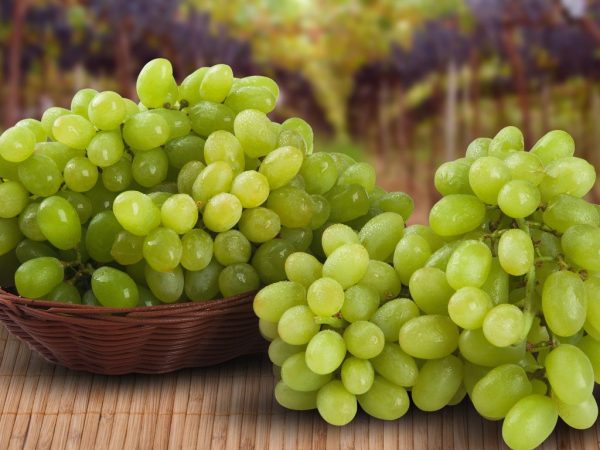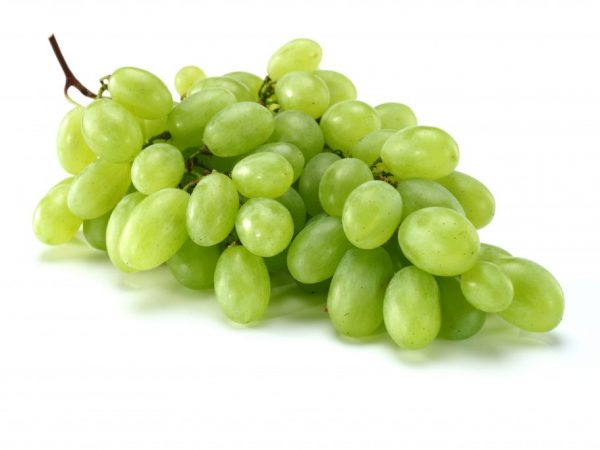Calorie content of green grapes
Grapes are a perennial shrub from the grape family. It is grown with their own hands to obtain fruits that are processed into drinks, jams or consumed raw. The calorie content of green grapes is important in diet planning.

Calorie content of green grapes
Popular varieties
Popular varieties of green grapes include:
- White miracle;
- Chardonnay;
- White nutmeg;
- Bazhena;
- Valentine.
These green grapes have a juicy, sweet-tasting pulp with a slight sourness, which is covered with a thin layer of skin. They also do not contain more than 2 seeds. Some varieties are used in winemaking, but most are suitable for consumption raw as an ingredient in weight loss. A large number of fruits can be harmful to the body.
Composition and calorie content
Depending on the variety, the calorie content of green grapes is 40-80 kcal per 100 g of berries, but in some it reaches 100 kcal. 1 spoon contains about 3 kcal, in a glass of 300 ml - less than 20 kcal. The volumetric component of water in fruits is 80-88%.
Nutritional value of green grapes per 100 g of product:
- carbohydrates - 16.1-18.4 g;
- fats - 0-0.023 g;
- proteins - 4-6.63 mg;
- nutritional fiber - 9.2-9.8 g;
- mineral substances - 98-121 g.
Chemicals in Green Grapes:
- chlorophyll;
- polyphenol;
- flavonoid;
- essential substances;
- quartzin
- food acids (malic, citric, succinic).
These indicators characterize green grapes as being low in calories and high in nutritional value. This makes it possible to use the fruits as one of the components of the menu in the diet for treatment and weight loss, as well as use them as a preventive vitamin and mineral complex without the risk of weight gain.
Useful components

Berries contain vitamins
The composition of vitamins of green grapes per 100 g:
- B1 (thiamine)
- B2 (riboflavin);
- A (P)
- E (T)
- E (TE)
The composition of trace elements per 100 g of the product:
- magnesium (Mg)
- calcium (Ca)
- phosphorus (Ph)
- iron (Fe)
- other elements
Use in cooking
Green grapes are used as part of a weight loss diet. Low calorie content allows you to consume large amounts of fruits without the risk of excess weight. The sweet taste of berries and firm flesh with a lot of juice make the product popular for consumption raw. Freshly harvested grapes need to be rinsed in cool running water or soaked in a liquid at room temperature to wash away dirt, dust and chemical residues.
To reduce calorie content without losing useful components, green grapes are cooked using heat treatment. Use the drying and curing method. This cooking takes a short time. Also, grapes are boiled for a short time in hot water or cooked in a steam bath.
In order not to increase the calorie content of the product, but to enhance its taste, the pickling method is used. Varieties with large berries are suitable for this.When pickling, spices are also added to make the flavor richer and more tart without increasing the calorie content.
Berries are used as an ingredient or decoration for low-calorie desserts and salads. Such dishes not only provide benefits for weight loss, but also improve the immune system, act as a means of preventing viral infections.
Cooking raisins
Green grapes produce delicious sweet raisins. The product does not lose its beneficial properties during cooking and does not increase the number of calories. It is used as an addition to desserts and salads.
Before cooking, the berries are prepared, which consists of a number of points:
- selection of ripe fruits without physical damage;
- cleaning by soaking in water;
- additional cleaning in boiling soda solution (5-10 seconds);
- washing from soda and drying.
Green grapes are processed into raisins by the following methods:
- indirect sunlight;
- direct light;
- heat treatment using technology.
Conclusion
Green grapes are healthy foods for adults and children. Most varieties are suitable for DIY cultivation.
Planting green varieties is best in mid-spring by cuttings. To ensure a large harvest, you need to regularly look after the bushes and make nitrogen, phosphorus and potassium fertilizers.


